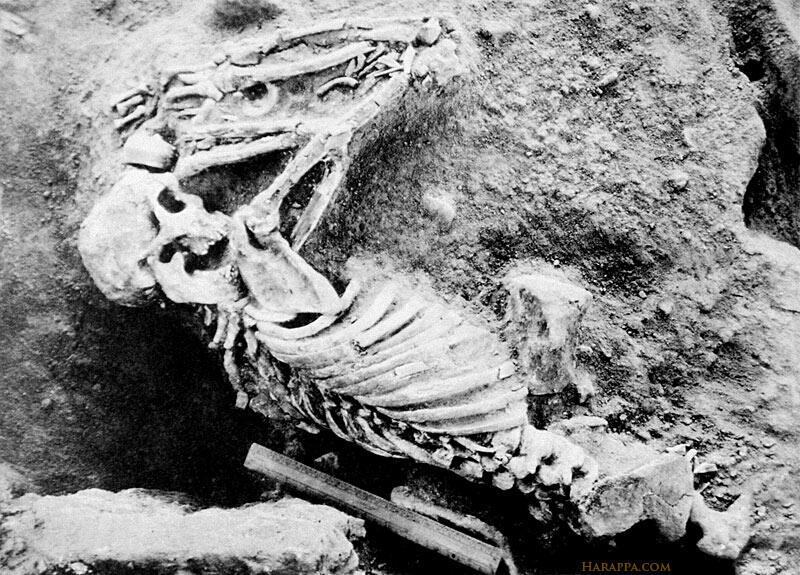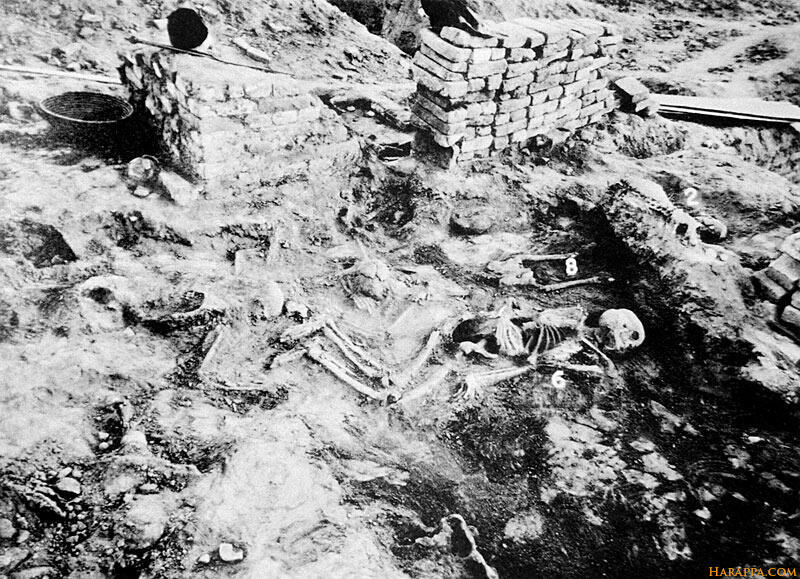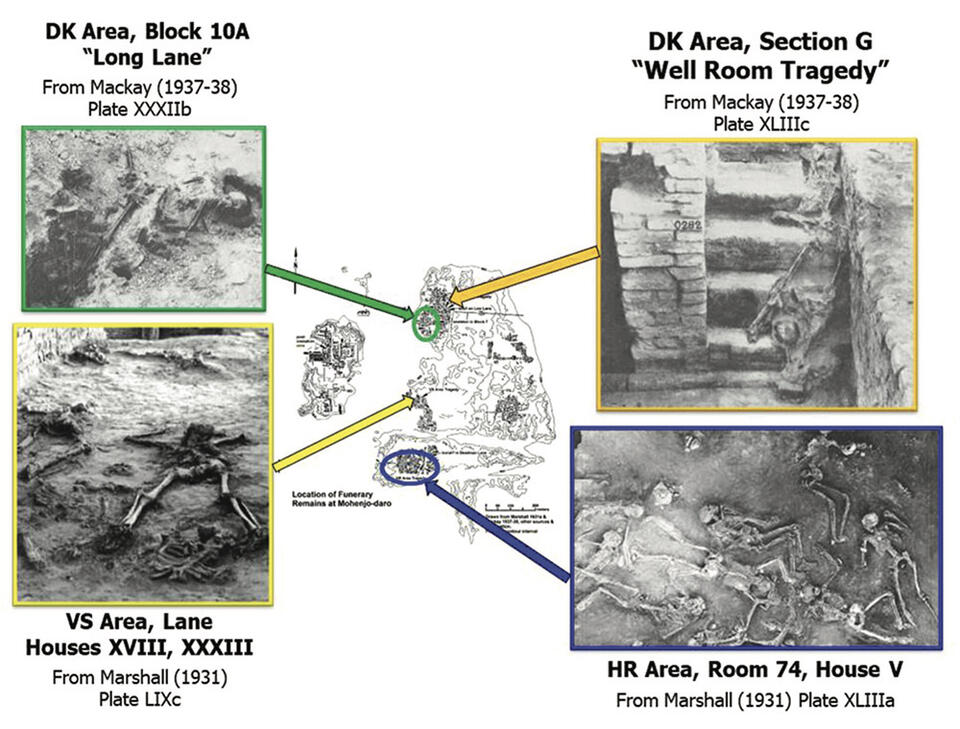This 40 page paper presents an in-depth analysis aiming to elucidate the biological affiliations of individuals found in atypical burial contexts at Mohenjo-daro through craniometric studies. This is murky stuff - craniometric studies or "the measurement of the skull and facial structure" - because such studies have long been discredited for their links to racism and prejudice in centuries past. Murky also because it is hard to deduce too much from them, especially since even if there is enough data from so far back, how does one account for the potential for convergent evolution or the possibility that craniometric similarities might not directly indicate cultural or genetic kinship?
The conclusion is not unexpected: "this [data] plot indicates that the so-called ‘massacre victims’ of Mohenjo-daro likely represent the remains of squatter populations from the west who interred their dead in the decrepit remains of this ancient city. No evidence supports the notion that these remains are those of ‘Aryan Invaders’ from the steppes of Central Asia or the hapless Mature Phase or Late Harappan residents of Mohenjo-daro" (p. 210). Still, the paper is valuable for some of the ancillary and related points raised and discussed. Like much research in recent times, it also suggests once again that populations thousands of years ago were very much in touch and circulating amongst each other. Exchange of ideas, products and genes was essential to the rise of civilization, in all directions.
One reason that the "identity" of the "massacre victims" is interesting is its relationship, possibly, to the decline of Indus civilization. The evidence is summarized by Hemphill: "During the course of excavations in the Lower Town by Marshall (1931) and Mackay (1938), skeletal remains were uncovered in non-mortuary contexts. Among others, these included one skeleton in Deadman’s Lane in Section A of the HR area, nine individuals from Block 10A in the in the DK Area, two from Section G in this same area, as well as six individuals (including one child) from Lane 4 separating Houses XVIII and XXXIII in the VS area and, most famous of all, some 14 individuals encompassing 13 adult males and females and one child in Room 74 of House V in the HR Area [see above images]" (p. 211-12). Early excavators had different explanations, and were rather circumspect, with Mackay suggesting they could have been raiding mountain tribes. It was Wheeler who made the famous statement (1947) that they were possible evidence of an "Aryan invasion," which he related to the Rg Veda and concluded with the famous lines: "It may be no mere chance that at a late period of Mohenjo-daro men, women and children appear to have been massacred there (Mackay 1938: 94–95, 116–117, 172). On circumstantial evidence, Indra stands accused" (Wheeler, 1947: 82, quoted on p. 212). Dr. George Dales offered a refutation of Wheeler's supposition in 1964, reiterating that the skeletons, their positions and relationship to the grounds they were found in "were not massacre victims at all, but likely represented the remains of bandits from the Baluchistan hills who left their dead in the long-abandoned city" (p. 213).
Brian Hemphill compares the morphology of the skeletons with those of other skeletons from the larger region and period from a number of places, including Xinjiang in China, Central Asia, Iran, Tibet, South China, and elsewhere. Enormously detailed measurements are compared across sexes, and it should be said that there is significant variation among populations making comparison to the Mohenjo-daro samples ("whose state of preservation . . . is rather poor," p. 213) itself complicated from a scientific perspective. Nonetheless, results suggest no strong connection with potentially invading tribes from the Russo-Kazakh steppe or Central Asia, again undermining an "Aryan invasion" hypothesis; more likely is Dales hypothesis that some of the victims bear resemblances to those from the west and possibly Baluchistan hills (p. 244). The author concludes (p. 244):
"This pattern of affinities is consistent with a population with connections to the west and northwest. It may be that with the breakdown of trade connections between the urban populations of the Indus Valley and with decentralization and increasing diversity, new groups from the western periphery may have penetrated the Indus Valley in an opportunistic and perhaps peripatetic fashion. The fact that the affinities of the alleged ‘massacre victims’ are to be found among the temporally antecedent populations to the west and northwest may be a reflection of the long-standing biological impacts of the vast interregional koine than spanned the 4th and 3rd millennia BC (Hiebert 1998: 4; Hiebert and Lamberg-Karlovsky 1992: 12; Jarrige 1994: 307; Jarrige and Hassan 1989: 150)."
This paper provides valuable insights into the bioarchaeological understanding of Mohenjo-daro, while highlighting the complexities and challenges in interpreting craniometric data within archaeological and historical frameworks. We may get a more final verdict with DNA or other analyses in the future assuming new bodies with enough material are found in the future or new methods allow the existing specimens to be re-interrogated. In the mean time this is the best we can do. Leaping to conclusions, with fragments from texts, pre-conceptions and prejudice, have a long life when data is sparse, and for that this analysis is a corrective. Certainly one might say that of little-warranted, long misleading speculation Sir Mortimer Wheeler stands firmly accused.
Images:
1. Group of skeletons in Room 74, House V.
2. Portion of skeleton found above southern wall of Room 74, House V.
3. Locations and illustrations of ‘massacre victims’ at Mohenjo-daro (modified after Mackay 1937 and Marshall 1931).






